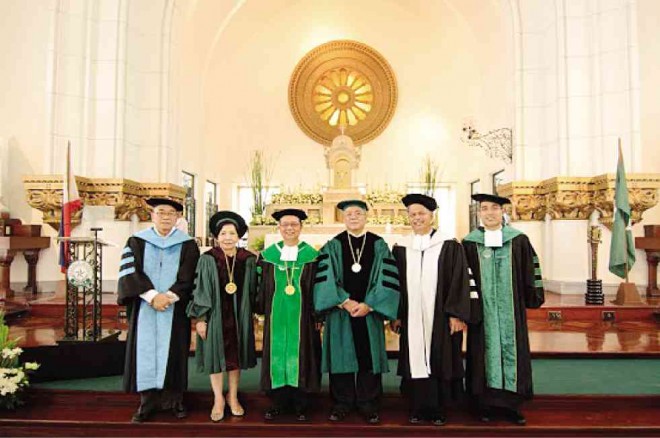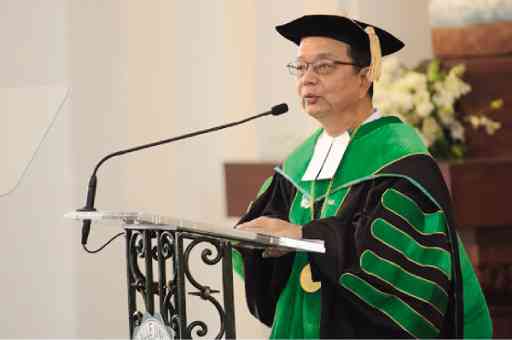New DLSU president faces K-12 challenge

(FROM left) Br. Narciso Erguiza Jr., former president and chancellor; Dr. Carmelita Quebengco, chancellor emeritus; Suplido; Janairo; Education Secretary Armin Luistro, former president, and Br. Ricardo Laguda, former president and chancellor
DE LA SALLE University (DLSU) and Ateneo de Manila University may be fierce competitors on the hard court but, at the investiture of the Taft school’s 23rd president and its fifth chancellor, there were only goodwill and good wishes from the Blue Eagles to the Green Archers.
Most of the priests who concelebrated the Mass with Manila Archbishop Luis Antonio Cardinal Tagle were Jesuits.
It was only fitting for Jesuits to join the “green” university in marking a milestone. Br. Raymundo Belardo Suplido, FSC, the new DLSU Taft president, received some of his education from Jesuit institutions—St. Louis University in Missouri, United States, and Pontifical Gregorian University in Rome, Italy—after his La Sallian formation.
As to be expected at this time when two significant developments are roiling the Philippine education system, both Suplido and Dr. Gerardo C. Janairo, the new DLSU chancellor, mentioned in their responses the Asean (Association of Southeast Asian Nations) integration and the adoption of the new 12-year basic education program, Kindergarten to Grade 12 (K-12), that would introduce Grade 11 next year and Grade 12 the year after.
Janairo said: “It is a daunting task, as we face the uncertainties of the K-12 transition and the opportunities provided by the Asean integration.” The chancellor, whose duties would be similar to a corporate chief operating officer in charge of day-to-day matters, gave the assurance that DLSU had taken steps to prepare for K-12 and the Asean integration.
Article continues after this advertisement“[A]llow me to assure you that … no full-time or permanent employee of the university will be put at a disadvantage … We are ready to roll out the Lasallian Roadmap to the Asean Community to help transition our university … We will strive to increase our competitiveness in the region and in the world,” he said.
Article continues after this advertisementSuplido, in an interview later, pointed out that the two developments were intertwined. Precisely because of the Asean integration, the new La Salle president did not see the wisdom of postponing the implementation of K-12.
“The Philippines is the second to—if not the last country offering a 10-year basic education. Our graduate degrees are put more and more in question because of the insufficient number of basic education years,” Suplido said.
With the Asean integration, he expects the discrepancy to be even more pronounced. “How competitive will our graduates be? Filipinos applying for positions in the Asean will be at a disadvantage” because of the shorter basic education program, he said.
Suplido said many students finished four years of college but were not ready for work. Many went to college unprepared so they spent the first two years of General Education (Gen Ed) just catching up or taking remedial classes.
Suplido said K-12 would help ensure that those who went to college were ready. Although higher education institutions (HEIs) would face serious financial problems because of few—even no—new college enrollees in 2016 and 2017, when senior high school (SHS) becomes fully operational, Suplido said, the program’s benefits far outweighed the difficulties.
The new La Salle president said various education stakeholders had taken and were taking steps to minimize the adverse impact of the transition.
Education Secretary Armin Luistro, a former DLSU president, had assured private school teachers, who might be retrenched or would have fewer teaching assignments because of K-12, that public schools were opening positions for them, Suplido said.

FOR SUPLIDO, K-12 cannot be postponed if Philippine education is to regain the respect and credibility of the past.
The Commission on Higher Education (CHEd) is preparing a budget to assist HEIs during the transition. Grants will be made available to faculty members to pursue graduate and postgraduate degrees or spend time in immersion in industry. HEIs can upgrade the quality of their faculties to prepare for the return to normalcy at no cost to them.
The CHEd is also drawing up a plan to help HEIs in certain regions upgrade their faculty and programs by asking centers of excellence to go out to the provinces to help strengthen their offerings, which would be cheaper than bringing prospective beneficiaries to Manila, Suplido said.
As for La Salle, he said, it was making arrangements with so-called La Salle feeder schools—other Lasallian institutions, neighbor St. Scholastica’s College and Poveda, for instance—that would not have enough teachers for Grades 11-12 to tap DLSU faculty members who would be idled or underutilized during the transition.
The arrangement, he said, would give senior high school students of feeder schools better preparation for college from HEI faculty members.
Suplido acknowledged the “pinch will be felt most by Gen Ed faculties,” as units would be reduced significantly because of senior high school.
DLSU, he said, had received suggestions from its own faculty. One plan is to let go of part-timers first. Full-timers may want to go into research or secondment to bigger schools.
“Faculty members say they won’t mind, knowing it’s transition time,” he said. They have expressed a willingness to serve as long as certain benefits are retained like uninterrupted service and retirement benefits, faculty aid for children, etc.
“Retiring faculty members will not be replaced,” Suplido said, “their load just redistributed.”
While the school is looking at every way it can reduce the number of those to be adversely affected, Suplido said, “if worse comes to worst, we may offer early retirement.” Administrators, he said, were discussing early retirement packages.
Also helpful, Suplido said, was a memorandum jointly issued by the Department of Education, Department of Labor and Employment, and Technical Education and Skills Development Authority (Tesda) allowing for transition contracts that, while slightly different from current work arrangements, would cushion the impact of the lean years.
Suplido is hopeful the drop in enrollment will not be so drastic and the adjustments they have made will allow them to weather the transition. He said many private and public schools had already made the shift from the 10-year program to the 12-year curriculum since the start of discussions about adopting K-12.
“A few (schools) will have graduated K-12 compliant students who can go straight to college,” he said. Although these new enrollees can go to other universities, Suplido hopes many will choose La Salle.
“Normally, we take in 3,500-4,000 freshmen. Our conservative estimate is 1,000 and the more optimistic expectation is 1,800,” he said.
He said they were trying to see what could be done to attract students during the lean years.
La Salle will also market its graduate programs more strongly, Suplido said. “We have the classrooms and the CHEd is providing some funds. Teachers who may be retrenched or will go on leave may want to pursue graduate studies … Many public school teachers may also be eager to obtain graduate or postgraduate degrees so they can move to SHS.”
Savings
While there would be a drop in revenue because of fewer new enrollees, DLSU also expects some savings as it cuts down on the use and maintenance of some facilities, reduced janitorial and other services, etc., Suplido said.
Suplido noted that private schools generally adopted the senior high school academic track while public institutions were more focused on technical-vocational (tech-voc) courses.
“Hopefully, SHS will change the attitude toward tech-voc,” he said, as he noted that Tesda qualification was equivalent to a college degree. If SHS was implemented well, more students would go into the tech-voc track, he said.
“People are beginning to see that some tech-voc graduates, like master plumbers, are paid more than some people with diplomas,” he said. To the credit of the Tesda, Suplido added, it has maintained the quality of its programs and its standards so skills certificates it issued are “really respected abroad.”
As for DLSU’s academic focus, Suplido does not expect a major shift, even with SHS and the Asean integration.
The major adjustment he anticipates is in the integration of La Salle’s educational mission as a Catholic university into what will finally emerge as the Gen Ed program. “We would have to see when La Sallian learning modules would be introduced.”
For, as Suplido said in his inaugural speech, despite K-12 and the Asean integration, DLSU’s first and foremost challenge is to sustain and maintain its status as “a leading learner-centered research university, bridging faith and scholarship in the service of society, especially the poor.”
Tagle, in his homily during the Mass, reminded Suplido of his primary responsibility. “Being president of a Catholic university is not just a position but a calling” and “every calling involves a mission,” the cardinal said.